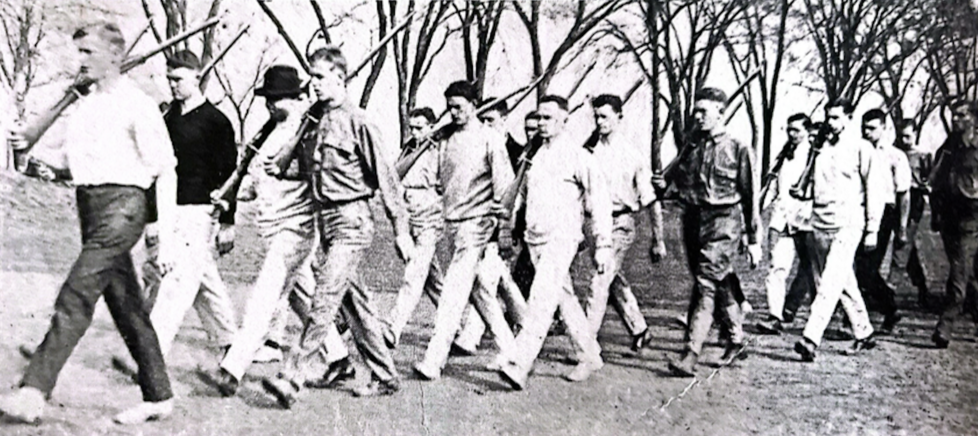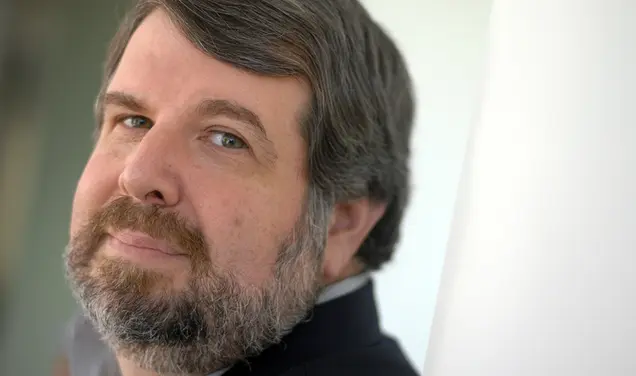On The Campus — WWII
To advertise its new V-1 program for recruiting officer material from the colleges, the Navy Department last week sent chief yeoman Henry M. Hughes Jr. ’41 to Princeton to make a movie of an undergraduate in a “mythical state college” who decided to enter the program along with his two roommates. While the Navy’s cameraman shrieked instructions, the typical freshman, “Dan” (Robert H. Chapman ’41), traipsed awkwardly across the campus wearing a dink and black tie, looked surprised and excited to find that he could enlist in the Navy and remain in college at the same time, and finally appeared in cap and gown to receive the congratulations of a gob who welcomes him into the armed forces. The undergraduate training of “Dan” and “Andy” is traced until graduation, but Harry, being a V-5 aspirant, leaves college at the end of sophomore year and comes back wearing his wings to watch his class graduate. The identity of the campus used in making the film will be a carefully shrouded secret when the film leaves on its tour of all the universities, colleges and junior colleges which are accredited for the new program; complete anonymity was maintained all through the picture. One shot of the “Prince” which announced the organization meeting for the new program was carefully censored so that no headline or caption might give an indication of the location of this “mythical state college.” Chapman, whose odyssey from dink to cap and gown took only two days, is now waiting to be inducted into the Navy; each evening he offers a silent prayer that none of his shipmates will ever see him crouching foolishly under that dink.
The V-1 program of training starts in freshman and sophomore years and will supplement Annapolis as a source of future officer material for the Navy. After Princeton had been accredited, Frank Knox, Secretary of the Navy, telegraphed to President Dodds: “The Navy is proud that your college has undertaken our V-1 plan for training freshmen and sophomores as officer material. Please tell your young men who apply for enlistment and training under this plan that they will be serving the nation if they continue their college course no less than those of your alumni who are already in service. The Navy knows your institution and your V-1 students will do their part.”
While Princeton is preparing for war with its variety of programs and courses, some of its undergraduates and faculty members are thinking about the peace and the post-war world. Whig-Clio and the “Prince,” in cooperation with the International Student Service, are sponsoring a conference over the weekend on the post-war world. Students from the college and nearby institutions will sit around conference tables with professors from the University faculty and from the Institute of Advanced Study to assess the prospects of a happier planet in the future. Meanwhile, the University has announced that the 1942 Stafford Little Lectures are devoted to some of the basic forces at work in American society and some of the resultant problems which will have to be solved during the war and the peace that follows, in order to achieve “Democracy’s ‘New Order.’” The scheduled speakers are Dr. Alva Myrdal, the Swedish sociologist; Jacob Viner, consulting expert of the Treasure Department since 1936 and professor of economics at Chicago; Sumner H. Slichter, Lamont professor of business economics at Harvard; and Peter H. Odegard, consultant to the Secretary of the Treasury on war bond sales and professor of political science at Amherst.
During examination period last June someone reputedly evoked the admission from one of the proctors that that particular exam period was one of the most subdued in recent years. What is usually a troublesome time had given the Dean’s Office a minimum of disciplinary cases. Whether the proctors ever made the admission or not was irrelevant. When it slipped into print and was read by an indignant student body, it was deeply resented. The undergraduates proceeded to show the defenders of order and righteousness that modern Princetonians could cause as much trouble as any of their predecessors and the Campus became the scene of a series of bonfires, every night for about a week. Just the other day we wondered what the effect of acceleration on such esprit would be, so we did a little snooping with the appropriate authorities. All we got was silence — cold, stony silence — not even a comment on the weather or on Houseparties next weekend.
This article was originally published in the April 24, 1924 issue of PAW.











No responses yet